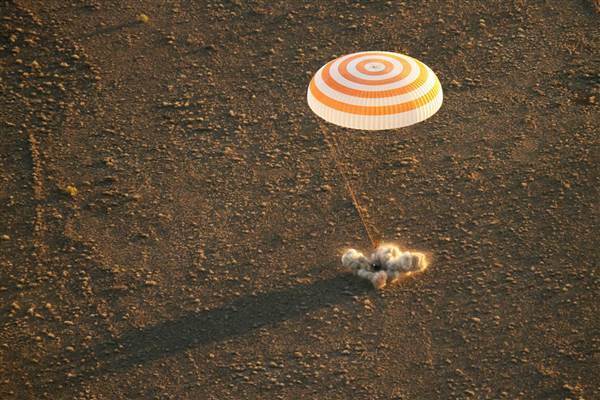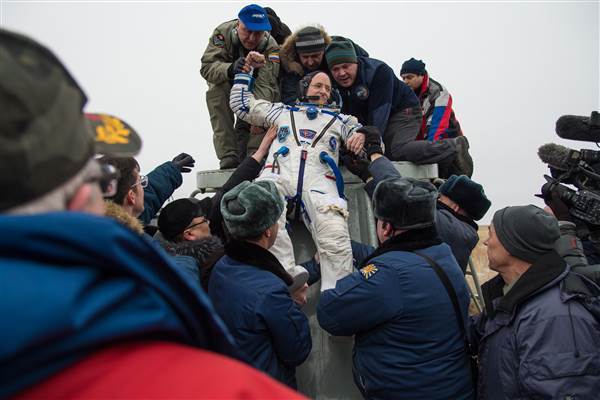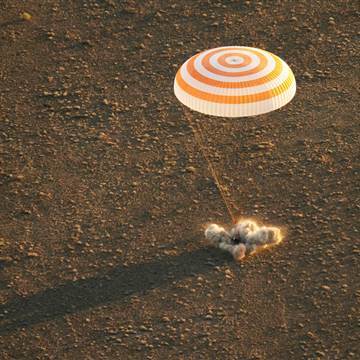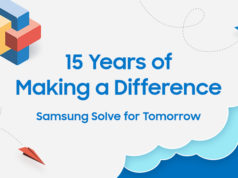Riding in Russia’s Soyuz spacecraft has been called the “ultimate rollercoaster ride back to the Earth.”
After a little more than three hours of fire, G-forces, extreme pendulum spinning, and exhilarating freefall, American astronaut Kate Rubins will land somewhere in the Kazakh steppe, in what will feel like a “controlled car crash.”
Rubins, a first-timer in space, is set to experience all this when she returns to Earth in a Soyuz spacecraft this weekend. The ride has famously been described as “like there was somebody outside the spacecraft with a sledgehammer that was hammering every few milliseconds.”
Rubins will be traveling back to Earth with Expedition 49 Commander Anatoly Ivanishin of the Russia and Takuya Onishi of the Japan Aerospace Exploration Agency Saturday night, sitting shoulder-to-shoulder inside the cramped Soyuz.
Their return will mark the end of a 115-day stay in space, where molecular biologist Rubins has been conducting around 100 different experiments including the effects of gravity on heart cells and bone growth.
Related: NASA Is Setting a Bunch of Fires in Space on Purpose
They’ll be in for a sensory overload as they hitch a three-hour ride home inside the Soyuz, Russia’s workhorse spacecraft, according to astronauts who have taken the trip. As a member of Expedition 24, Tracy Caldwell Dyson traveled back to Earth in a Soyuz in 2010, after spending 176 days in space.
“You’re seeing things like your capsule ablating as it goes through the atmosphere and you’re smelling the charring as it’s happening,” Dyson told NBC News. “You’re watching the transition from the blackness of space and the beautiful blue and white glow of the Earth to all of a sudden, streaks of orange, red and yellow fire.”
After saying their goodbyes to their colleagues, the trio are set to undock from the International Space Station at 8:37 p.m. ET on Saturday. With the Russian commander in the middle, Dyson said Rubins will get a window seat for the ride home.
When the Soyuz is a safe distance from the space station, its engines will fire for several minutes to conduct a de-orbit burn, allowing it to drop from orbit and shed its descent module and instrument compartment.
With a lighter load, the orbital module carrying the three astronauts will be ready to continue an exhilarating free-fall re-entering Earth’s hot atmosphere.
This is described as the most “stressful” moment of the trip — and astronauts will be protected from the extreme temperatures with a heat shield as they plummet back to Earth. About 15 minutes before landing, the Soyuz will deploy parachutes to help it decelerate.
There’s fire and insane G-forces, but the most memorable part of the experience for Dyson was the feeling when the parachutes opened.
“It creates a jolt like you’ve never experienced before and probably never will in your entire life unless you ride in the Soyuz,” she said.


The capsule will spin and sway back and forth like a pendulum as the parachutes unwind, she said, with the most dramatic effects being felt by the astronauts to the left and right of the commander.
Previous landings have shown the Soyuz doesn’t always stick a perfect touchdown, with the capsule sometimes landing on its side.
Shortly after touchdown, a crew will drive to the Soyuz, where the astronauts will be pulled out of the spacecraft one by one and placed into chairs. This allows them to not only regain their Earth legs but also provides the traditional Russian photo op.


This is far from the last American ride in the Soyuz, but its years of carrying American astronauts may be coming to an end.
Reliance on the Soyuz could end by 2019 when NASA’s commercial crew partners, SpaceX and Boeing, take over the duty of transporting American astronauts to the space station.
Hitching a ride with the Russians doesn’t come cheap. NASA currently pays $81 million per seat — but a ride on the SpaceX Crew Dragon or the Boeing CST-100 Starliner will run NASA $58 million, making them a relative bargain to the Soyuz.







